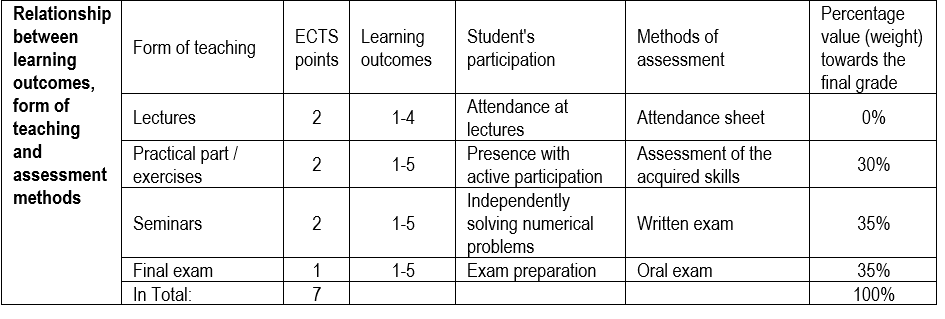Students will learn about biomolecules in the human body and about basic rules and mechanisms of biochemical activities that constitute the foundation to understand life processes of a healthy and ill body.
Introduction: biochemistry, molecular bases of life, atom structure, chemical bond, intermolecular forces.
Water: structure, properties, hydrogen bond, hydrophobic interactions, water as solvent, water as reagent.
Solvents: dissolution of gases in water (Henry’s law), colligative properties of solvents (Raoult’s law, freezing-point depression, boiling-point elevation, osmotic pressure), osmosis within cell (tonicity, Donnan equilibrium, passive transport - Fick’s law).
pH: water ionisation, Kᵥᵥ, pH, weak and strong electrolytes, acids and alkali (titration curve, Kₐ, Kb, pKₐ, pKb), buffers (Henderson-Hasselbalch equation), buffer systems in body, biological significance of ph.
Thermodynamics: laws of thermodynamics, thermodynamic functions, standard condition, chemical potential, spontaneous and non-spontaneous processes.
Chemical equilibrium: chemical, kinetic and thermodynamic aspect of chemical equilibrium, impact of pH concentration and temperature on chemical equilibrium; solubility product; complex reactions, role of ATP in complex processes, active transport.
Oxidation-reduction: definition, quantitative characterisation of redox reaction (Nernst equation); redox potential and standard reaction enthalpy; photosynthesis and respiration in the redox system of cell.
Reaction rate: definition, order and molecularity of reactions; reaction rate and equilibrium (energy profile of reaction); impact of concentration, of pH, of ionic forces and of temperature on reaction rate; catalysis.
Molecular bases of life: biologically significant elements, ions and biomolecules.
Carbon atom: electronic configuration, resonance, steric properties; bond between carbon atoms and between carbon and other elements.
Organic biomolecule: isometry; mutual influence of functional groups (inductive and resonant effect); short overview of organic bonds according to functional groups and biochemical significance.
Carbohydrates: chemistry of sugar; monosaccharides; disaccharides; polysaccharides-homoglycans and heteroglycans; enzyme degradation of glycosidic bonds; detoxification of organic compounds in the body; simple and complex polysaccharides; glycoproteins; bacterial cell wall; cell surface - membrane properties; blood types.
Lipids - simple and complex: fatty acids, triacylglycerols, sphingolipids; lipoproteins, liposomes;
biological membrane - structure and function; prostaglandins and terpenes.
Steroids: general properties, classification, chemistry of steroids, isometry of steroids, sterols, bile acids; steroid hormones - classification, structure and properties; basics of hormone impact on a molecular level.
Nucleotides: purine and pyrimidine bases, nucleosides and nucleotides - structure and nomenclature. Nucleotides and their role in energy transmission; cyclic nucleotides as second messenger, nucleotides as components of nucleic acids.
Nucleic acids: types of nucleic acids, structure and biological role; definition and structural properties of genes; foundations of application, transcription and translation; mutations; structure of human genome, project of human genome, genomics, proteomics, understanding cause and consequences of genetic illnesses on molecular level.
Vitamins: vitamins classification; vitamins (thiamine, riboflavin, nicotine acid, folic acid, vitamin C, cobalamin, structure and biological role), coenzymes and prosthetic groups; vitamins (vitamins A, D, E, K, structure and biological role).
Amino acids: structure, properties, nomenclature; isoelectric and isoionic point; amino acids analysis.
Peptides: biologically active peptides; biogenic amines; structural bases of the effect of peptide hormones and biogenic amines.
Proteins: general structure and properties; types according to function (enzymes, transport, reserve, contractile, structural, defensive and regulation protein); types according to structure (fibrillar and globular protein).
Protein structure: primary structure - sequence; secondary structure (α-helix, β-structure); tertiary and quaternary structure; conformation and conformation change.
Fibrillar proteins: α-keratin, collagen and elastin-structure and function. Monomeric and oligomeric structure of proteins: myoglobin and haemoglobin.
Contractile proteins: muscle contractile proteins (myosin, actin, troponin and tropomyosin); contraction of striated and smooth muscles; non-muscular contractile proteins (kinesin and dynein). Membrane proteins: in the membrane of erythrocytes (glychophorin, spectrin, transport protein for anions); Na⁺/K⁺-ATPase; G-proteins (structure and role during hormone activity); insulin receptor; rhodopsin (visual cycle).
Enzymes: basic properties; enzyme kinetics (Michaelis-Menten kinetics, multi-substrate kinetics, cooperation, inhibition and activation); mechanisms of enzyme reactions; regulation of enzyme activity (allosteric modulation), covalent modification glycogen phosphorylase), regulation through proteolytic enzymes (trypsin); enzyme classification and nomenclature.
Other proteins: apoproteins of plasma lipoproteins; immunoglobulins (structure and molecular base of immune response).
Conclusion: functional connection - from biomolecule to complex cell structure.
Required course materials:
1. Sikirica, M. Stehiometrija, Šk. Knjiga; zagreb, 2001.
2. P.W. Atkins, M.J. Clugston: "NACELA FIZIKALNE KEMIJE", "Školska knjiga" Zagreb, 1992.
3. Mladena Kirigin: "ORGANSKA KEMIJA", Sveučilište u Rijeci, Medicinski fakultet - Rijeka, 1996.
4. N. Burger: Zbirka zadataka iz kemije, Medicinska naklada, Zagreb 2008.
5. 28 izdanje Harperova ilustrirana biokemija, Medicinska naklada 2010.
6. Glavaš-Obrovac Lj. I sur. Interni priručnik za seminare i vježbe iz Medicinske kemije i biokemije 1, Medicinski fakultet Osijek, 2010.
Upon completion of this course, students will be able to:
1. Compare the basic classes of chemical bonds and physical-chemical principles for gases and solutions
2. Identify the structure and reactions of the main biochemical compounds including small, large, and supramolecular structures that are present in living cells
3. Evaluate the distinct chemical changes in relation to specific physiological and/or pathophysiological process
4. Critically evaluate the main physiological processes on the cell level as well as on the level of organic systems and the whole human organism
5. Validate the acquired knowledge by solving the numerical problems and through laboratory exercises.



